Health Challenges and Kidney Disease in Aboriginal Population
VerifiedAdded on 2023/01/18
|10
|1498
|77
AI Summary
This report focuses on the health challenges and kidney disease in the Aboriginal population in Australia, highlighting the nature of the health problem, population affected, magnitude of the health problem, proximal and distal determinants, additional features of the targeted population, and the requirement of a public health intervention strategy.
Contribute Materials
Your contribution can guide someone’s learning journey. Share your
documents today.
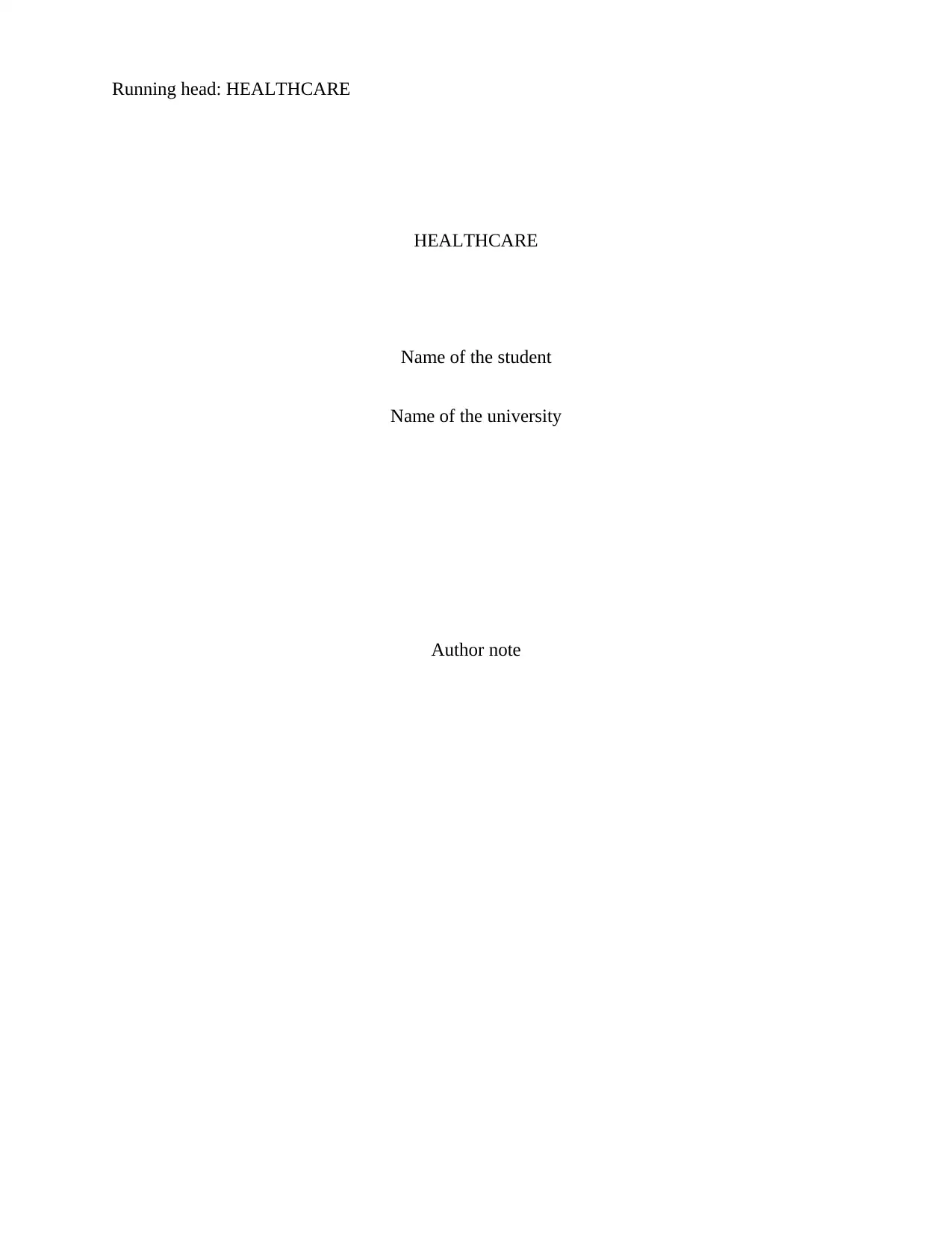
Running head: HEALTHCARE
HEALTHCARE
Name of the student
Name of the university
Author note
HEALTHCARE
Name of the student
Name of the university
Author note
Secure Best Marks with AI Grader
Need help grading? Try our AI Grader for instant feedback on your assignments.
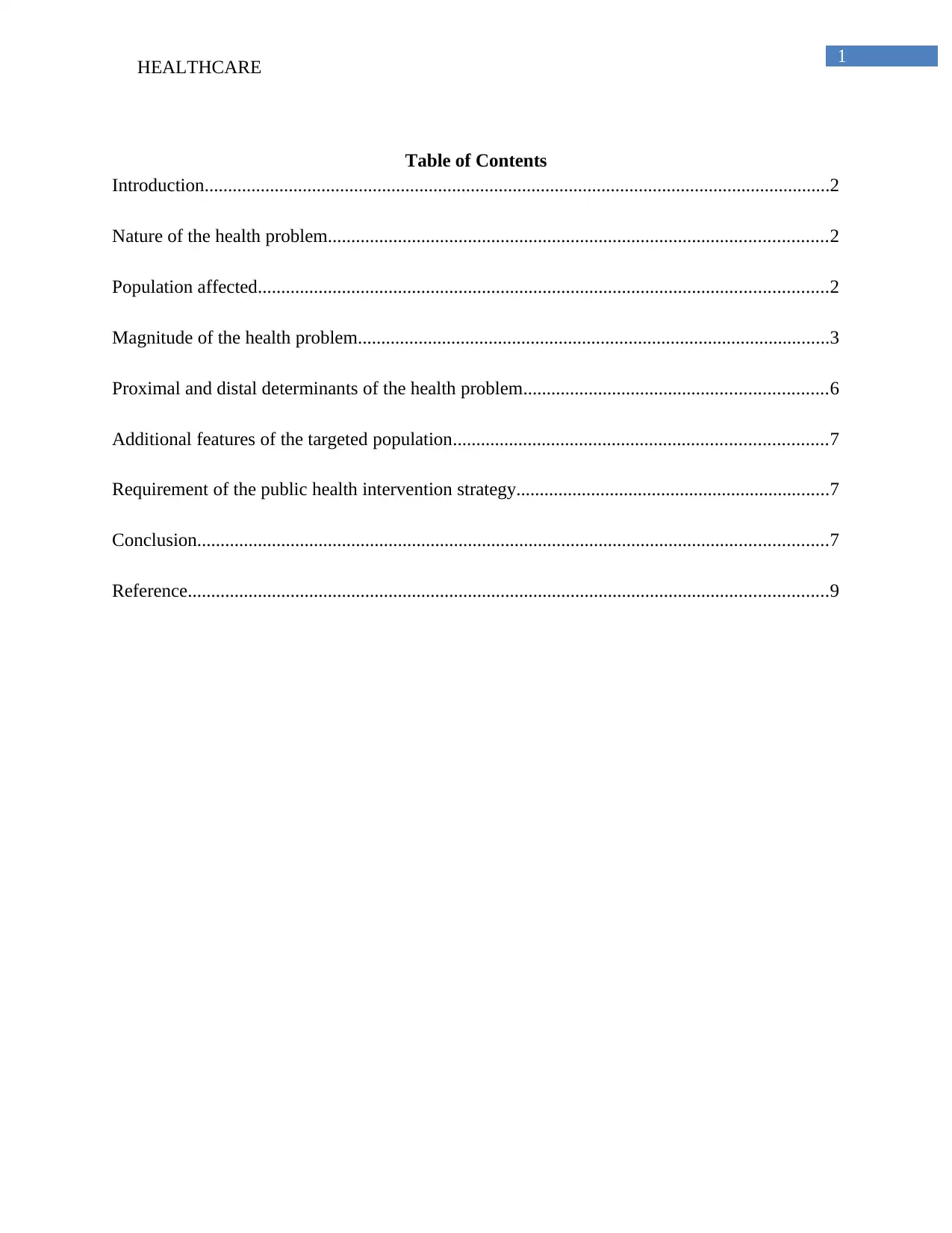
1
HEALTHCARE
Table of Contents
Introduction......................................................................................................................................2
Nature of the health problem...........................................................................................................2
Population affected..........................................................................................................................2
Magnitude of the health problem.....................................................................................................3
Proximal and distal determinants of the health problem.................................................................6
Additional features of the targeted population................................................................................7
Requirement of the public health intervention strategy...................................................................7
Conclusion.......................................................................................................................................7
Reference.........................................................................................................................................9
HEALTHCARE
Table of Contents
Introduction......................................................................................................................................2
Nature of the health problem...........................................................................................................2
Population affected..........................................................................................................................2
Magnitude of the health problem.....................................................................................................3
Proximal and distal determinants of the health problem.................................................................6
Additional features of the targeted population................................................................................7
Requirement of the public health intervention strategy...................................................................7
Conclusion.......................................................................................................................................7
Reference.........................................................................................................................................9
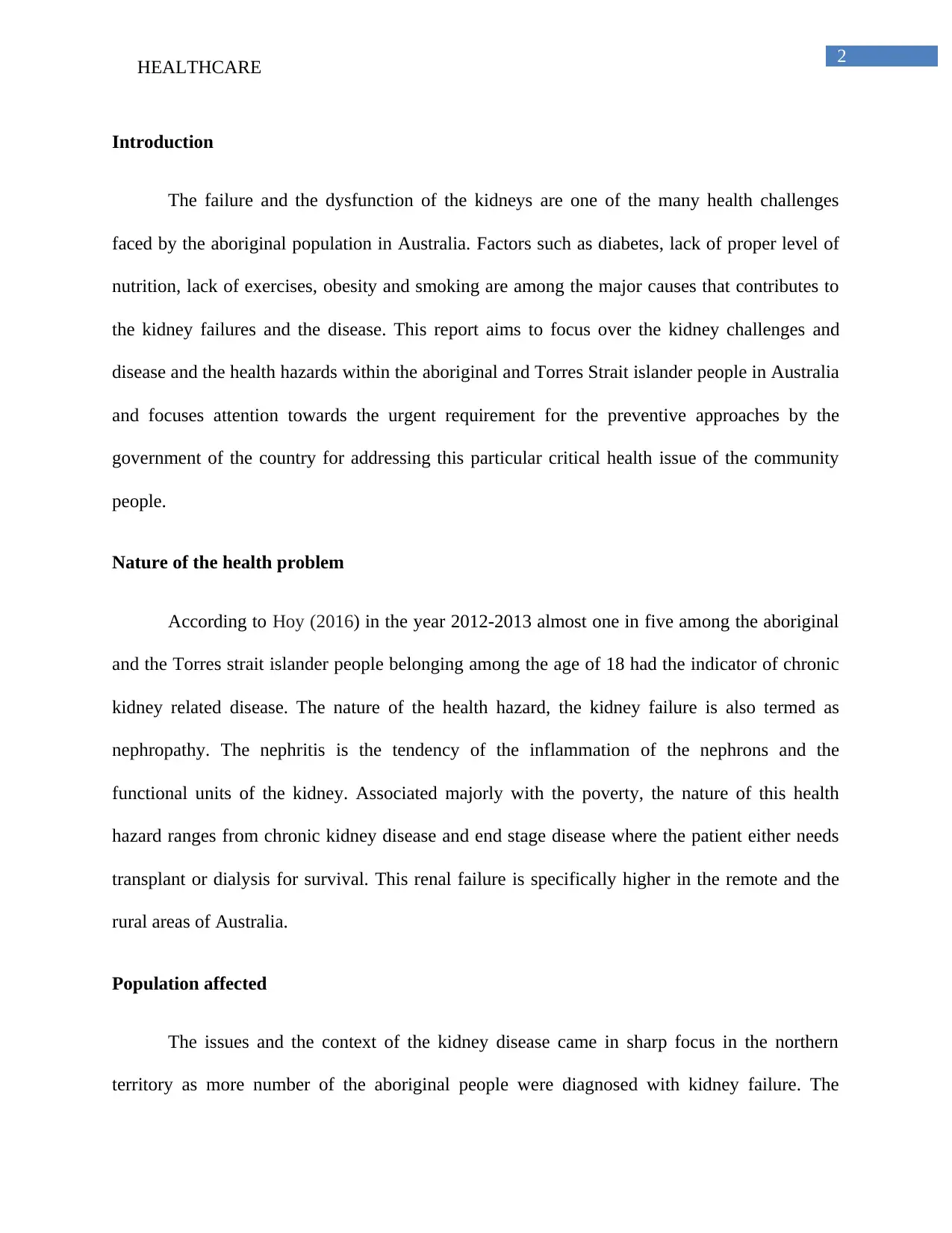
2
HEALTHCARE
Introduction
The failure and the dysfunction of the kidneys are one of the many health challenges
faced by the aboriginal population in Australia. Factors such as diabetes, lack of proper level of
nutrition, lack of exercises, obesity and smoking are among the major causes that contributes to
the kidney failures and the disease. This report aims to focus over the kidney challenges and
disease and the health hazards within the aboriginal and Torres Strait islander people in Australia
and focuses attention towards the urgent requirement for the preventive approaches by the
government of the country for addressing this particular critical health issue of the community
people.
Nature of the health problem
According to Hoy (2016) in the year 2012-2013 almost one in five among the aboriginal
and the Torres strait islander people belonging among the age of 18 had the indicator of chronic
kidney related disease. The nature of the health hazard, the kidney failure is also termed as
nephropathy. The nephritis is the tendency of the inflammation of the nephrons and the
functional units of the kidney. Associated majorly with the poverty, the nature of this health
hazard ranges from chronic kidney disease and end stage disease where the patient either needs
transplant or dialysis for survival. This renal failure is specifically higher in the remote and the
rural areas of Australia.
Population affected
The issues and the context of the kidney disease came in sharp focus in the northern
territory as more number of the aboriginal people were diagnosed with kidney failure. The
HEALTHCARE
Introduction
The failure and the dysfunction of the kidneys are one of the many health challenges
faced by the aboriginal population in Australia. Factors such as diabetes, lack of proper level of
nutrition, lack of exercises, obesity and smoking are among the major causes that contributes to
the kidney failures and the disease. This report aims to focus over the kidney challenges and
disease and the health hazards within the aboriginal and Torres Strait islander people in Australia
and focuses attention towards the urgent requirement for the preventive approaches by the
government of the country for addressing this particular critical health issue of the community
people.
Nature of the health problem
According to Hoy (2016) in the year 2012-2013 almost one in five among the aboriginal
and the Torres strait islander people belonging among the age of 18 had the indicator of chronic
kidney related disease. The nature of the health hazard, the kidney failure is also termed as
nephropathy. The nephritis is the tendency of the inflammation of the nephrons and the
functional units of the kidney. Associated majorly with the poverty, the nature of this health
hazard ranges from chronic kidney disease and end stage disease where the patient either needs
transplant or dialysis for survival. This renal failure is specifically higher in the remote and the
rural areas of Australia.
Population affected
The issues and the context of the kidney disease came in sharp focus in the northern
territory as more number of the aboriginal people were diagnosed with kidney failure. The
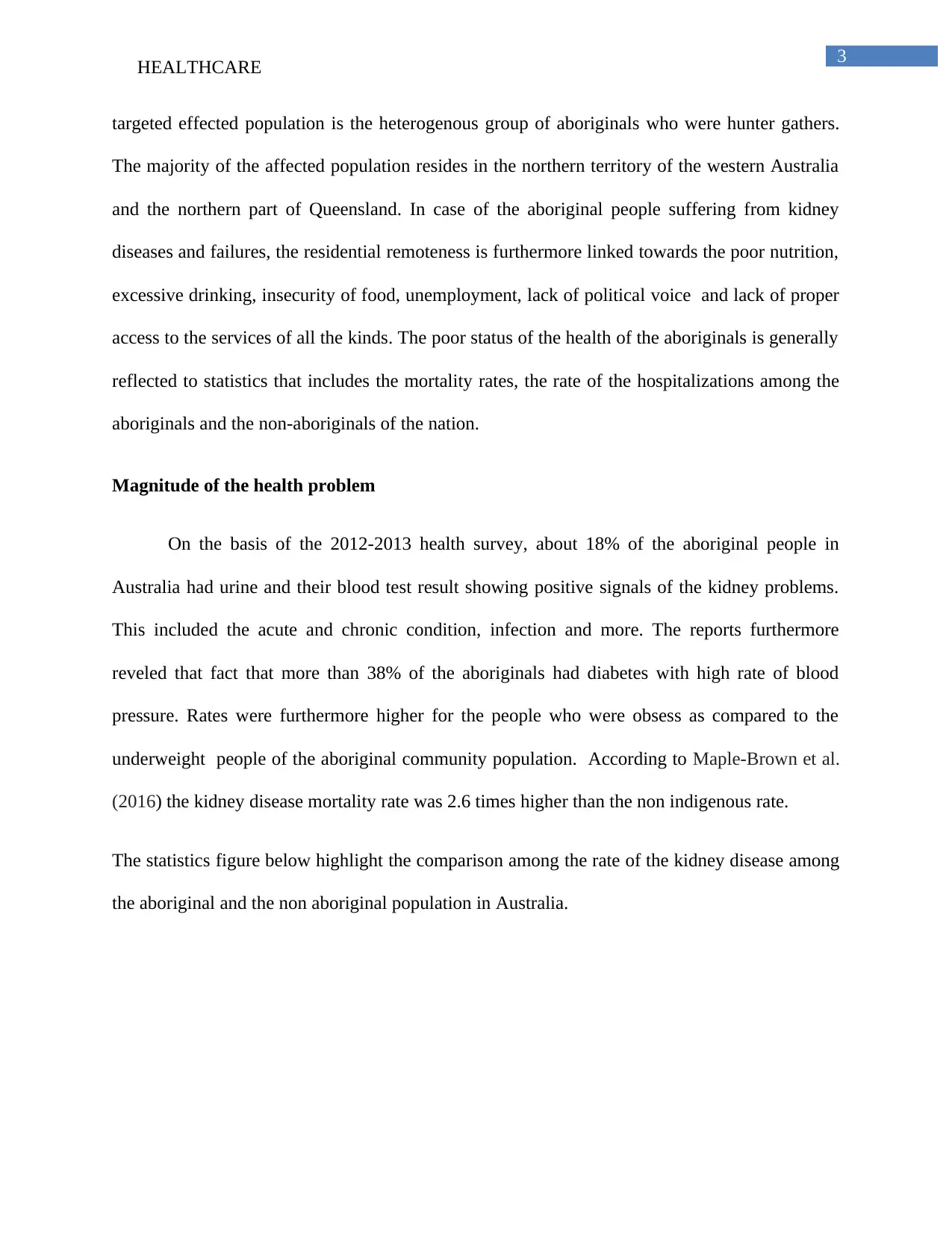
3
HEALTHCARE
targeted effected population is the heterogenous group of aboriginals who were hunter gathers.
The majority of the affected population resides in the northern territory of the western Australia
and the northern part of Queensland. In case of the aboriginal people suffering from kidney
diseases and failures, the residential remoteness is furthermore linked towards the poor nutrition,
excessive drinking, insecurity of food, unemployment, lack of political voice and lack of proper
access to the services of all the kinds. The poor status of the health of the aboriginals is generally
reflected to statistics that includes the mortality rates, the rate of the hospitalizations among the
aboriginals and the non-aboriginals of the nation.
Magnitude of the health problem
On the basis of the 2012-2013 health survey, about 18% of the aboriginal people in
Australia had urine and their blood test result showing positive signals of the kidney problems.
This included the acute and chronic condition, infection and more. The reports furthermore
reveled that fact that more than 38% of the aboriginals had diabetes with high rate of blood
pressure. Rates were furthermore higher for the people who were obsess as compared to the
underweight people of the aboriginal community population. According to Maple-Brown et al.
(2016) the kidney disease mortality rate was 2.6 times higher than the non indigenous rate.
The statistics figure below highlight the comparison among the rate of the kidney disease among
the aboriginal and the non aboriginal population in Australia.
HEALTHCARE
targeted effected population is the heterogenous group of aboriginals who were hunter gathers.
The majority of the affected population resides in the northern territory of the western Australia
and the northern part of Queensland. In case of the aboriginal people suffering from kidney
diseases and failures, the residential remoteness is furthermore linked towards the poor nutrition,
excessive drinking, insecurity of food, unemployment, lack of political voice and lack of proper
access to the services of all the kinds. The poor status of the health of the aboriginals is generally
reflected to statistics that includes the mortality rates, the rate of the hospitalizations among the
aboriginals and the non-aboriginals of the nation.
Magnitude of the health problem
On the basis of the 2012-2013 health survey, about 18% of the aboriginal people in
Australia had urine and their blood test result showing positive signals of the kidney problems.
This included the acute and chronic condition, infection and more. The reports furthermore
reveled that fact that more than 38% of the aboriginals had diabetes with high rate of blood
pressure. Rates were furthermore higher for the people who were obsess as compared to the
underweight people of the aboriginal community population. According to Maple-Brown et al.
(2016) the kidney disease mortality rate was 2.6 times higher than the non indigenous rate.
The statistics figure below highlight the comparison among the rate of the kidney disease among
the aboriginal and the non aboriginal population in Australia.
Secure Best Marks with AI Grader
Need help grading? Try our AI Grader for instant feedback on your assignments.
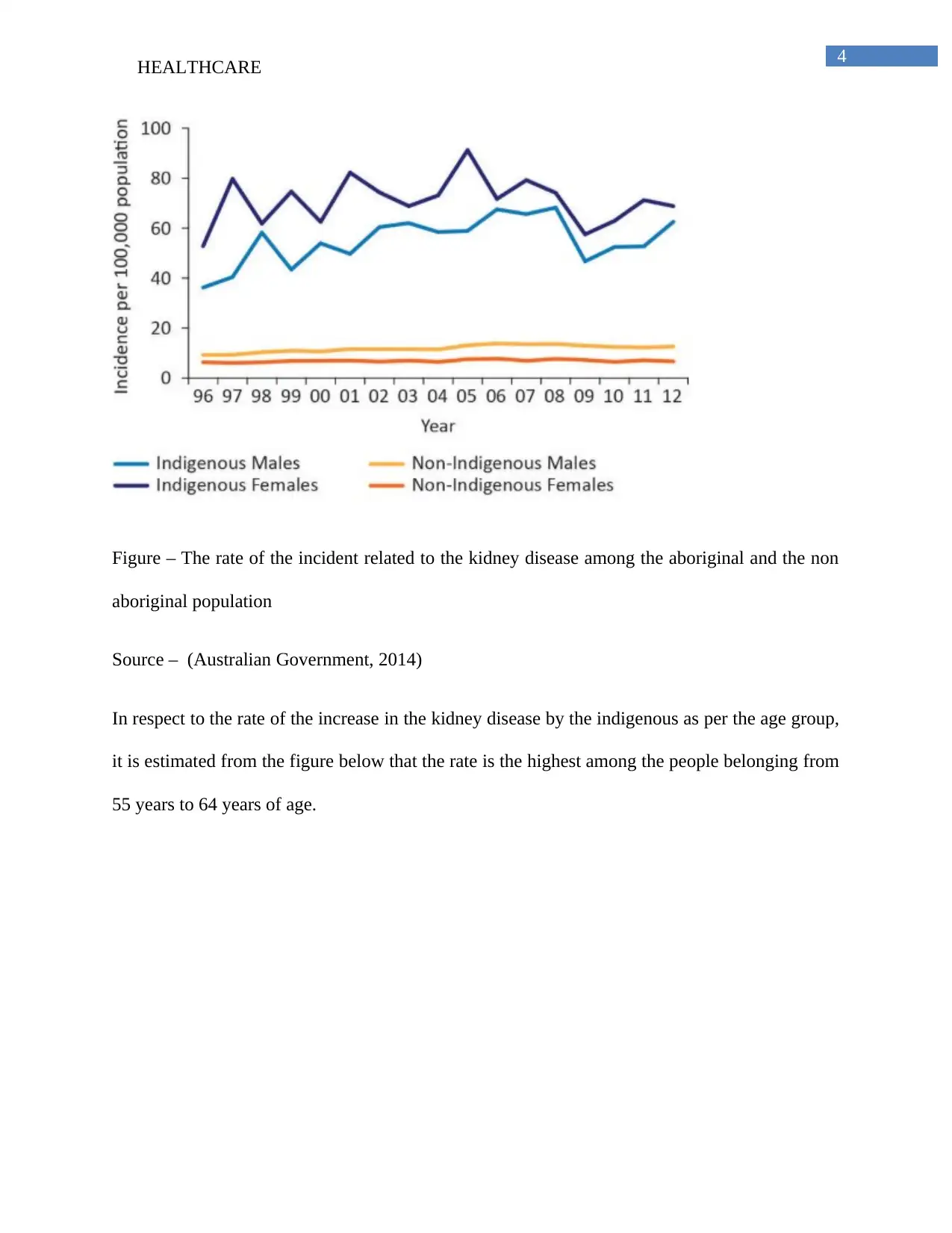
4
HEALTHCARE
Figure – The rate of the incident related to the kidney disease among the aboriginal and the non
aboriginal population
Source – (Australian Government, 2014)
In respect to the rate of the increase in the kidney disease by the indigenous as per the age group,
it is estimated from the figure below that the rate is the highest among the people belonging from
55 years to 64 years of age.
HEALTHCARE
Figure – The rate of the incident related to the kidney disease among the aboriginal and the non
aboriginal population
Source – (Australian Government, 2014)
In respect to the rate of the increase in the kidney disease by the indigenous as per the age group,
it is estimated from the figure below that the rate is the highest among the people belonging from
55 years to 64 years of age.
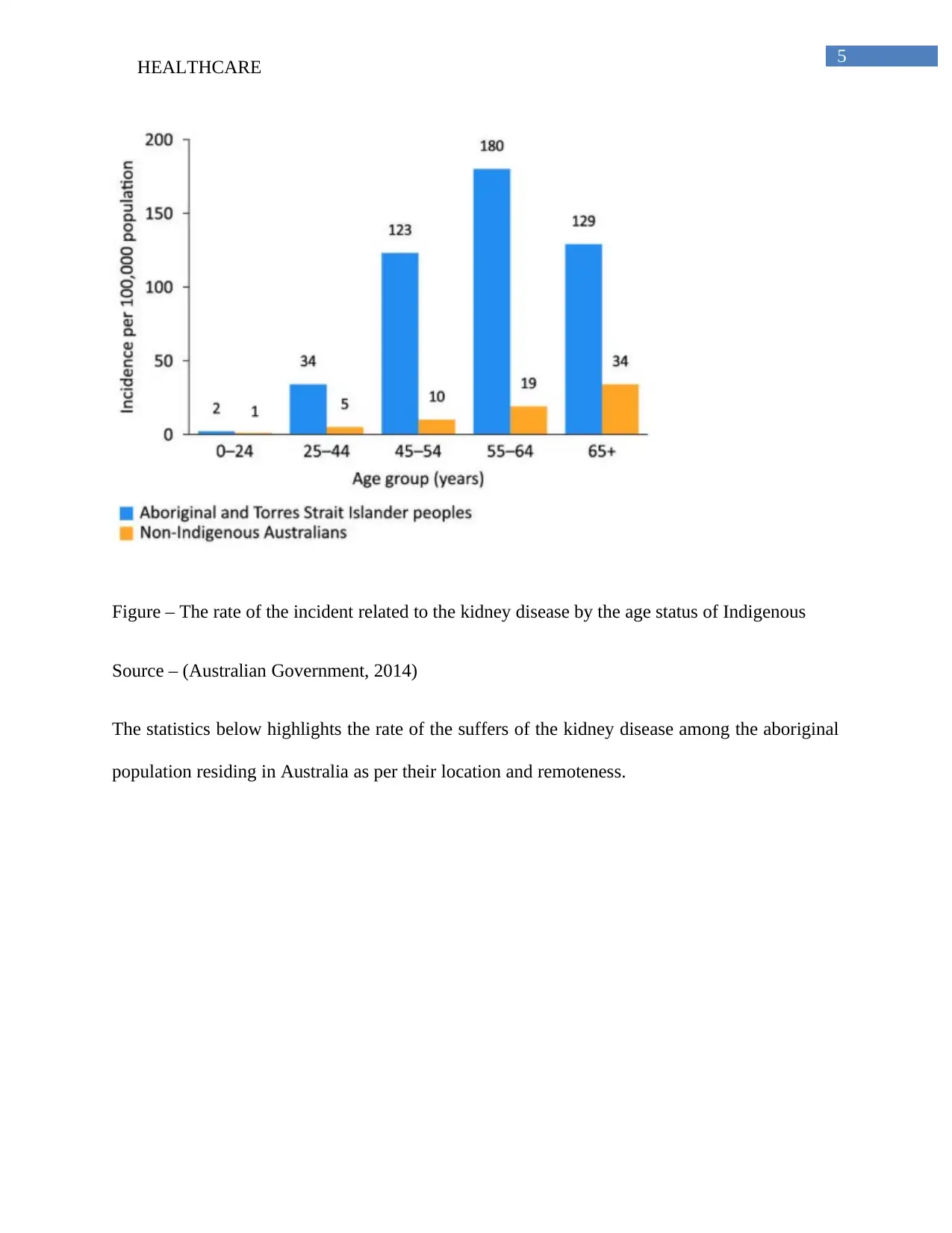
5
HEALTHCARE
Figure – The rate of the incident related to the kidney disease by the age status of Indigenous
Source – (Australian Government, 2014)
The statistics below highlights the rate of the suffers of the kidney disease among the aboriginal
population residing in Australia as per their location and remoteness.
HEALTHCARE
Figure – The rate of the incident related to the kidney disease by the age status of Indigenous
Source – (Australian Government, 2014)
The statistics below highlights the rate of the suffers of the kidney disease among the aboriginal
population residing in Australia as per their location and remoteness.
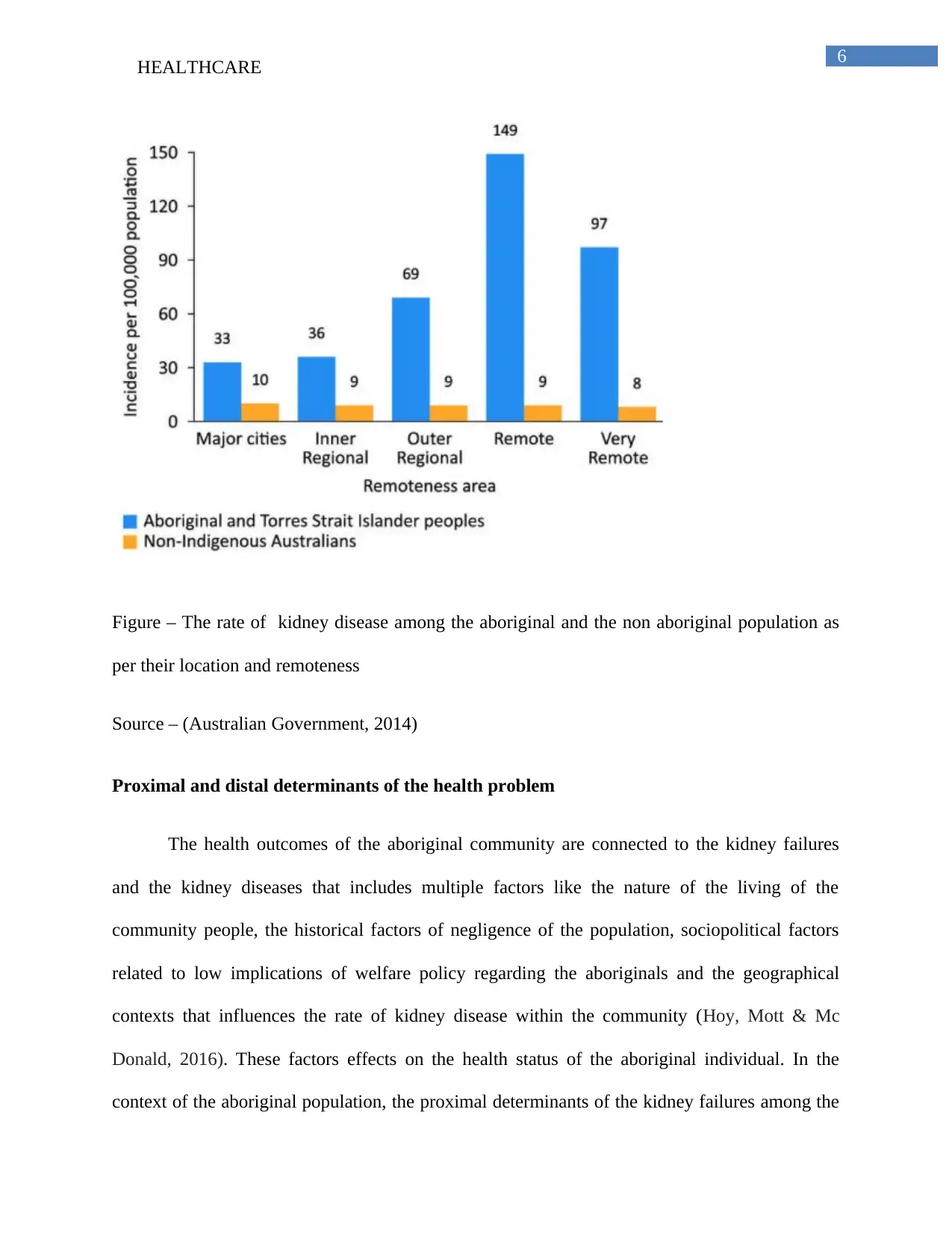
6
HEALTHCARE
Figure – The rate of kidney disease among the aboriginal and the non aboriginal population as
per their location and remoteness
Source – (Australian Government, 2014)
Proximal and distal determinants of the health problem
The health outcomes of the aboriginal community are connected to the kidney failures
and the kidney diseases that includes multiple factors like the nature of the living of the
community people, the historical factors of negligence of the population, sociopolitical factors
related to low implications of welfare policy regarding the aboriginals and the geographical
contexts that influences the rate of kidney disease within the community (Hoy, Mott & Mc
Donald, 2016). These factors effects on the health status of the aboriginal individual. In the
context of the aboriginal population, the proximal determinants of the kidney failures among the
HEALTHCARE
Figure – The rate of kidney disease among the aboriginal and the non aboriginal population as
per their location and remoteness
Source – (Australian Government, 2014)
Proximal and distal determinants of the health problem
The health outcomes of the aboriginal community are connected to the kidney failures
and the kidney diseases that includes multiple factors like the nature of the living of the
community people, the historical factors of negligence of the population, sociopolitical factors
related to low implications of welfare policy regarding the aboriginals and the geographical
contexts that influences the rate of kidney disease within the community (Hoy, Mott & Mc
Donald, 2016). These factors effects on the health status of the aboriginal individual. In the
context of the aboriginal population, the proximal determinants of the kidney failures among the
Paraphrase This Document
Need a fresh take? Get an instant paraphrase of this document with our AI Paraphraser
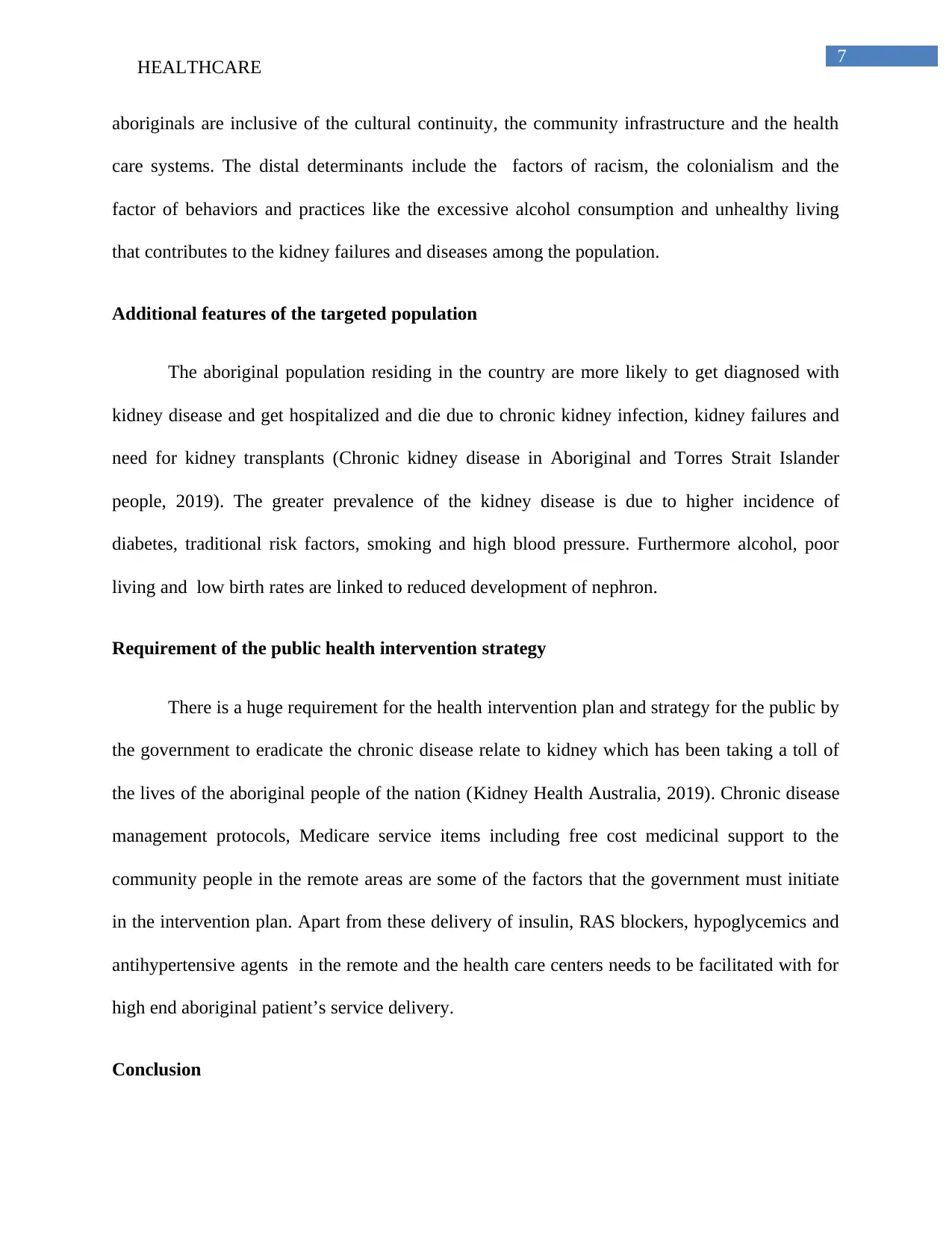
7
HEALTHCARE
aboriginals are inclusive of the cultural continuity, the community infrastructure and the health
care systems. The distal determinants include the factors of racism, the colonialism and the
factor of behaviors and practices like the excessive alcohol consumption and unhealthy living
that contributes to the kidney failures and diseases among the population.
Additional features of the targeted population
The aboriginal population residing in the country are more likely to get diagnosed with
kidney disease and get hospitalized and die due to chronic kidney infection, kidney failures and
need for kidney transplants (Chronic kidney disease in Aboriginal and Torres Strait Islander
people, 2019). The greater prevalence of the kidney disease is due to higher incidence of
diabetes, traditional risk factors, smoking and high blood pressure. Furthermore alcohol, poor
living and low birth rates are linked to reduced development of nephron.
Requirement of the public health intervention strategy
There is a huge requirement for the health intervention plan and strategy for the public by
the government to eradicate the chronic disease relate to kidney which has been taking a toll of
the lives of the aboriginal people of the nation (Kidney Health Australia, 2019). Chronic disease
management protocols, Medicare service items including free cost medicinal support to the
community people in the remote areas are some of the factors that the government must initiate
in the intervention plan. Apart from these delivery of insulin, RAS blockers, hypoglycemics and
antihypertensive agents in the remote and the health care centers needs to be facilitated with for
high end aboriginal patient’s service delivery.
Conclusion
HEALTHCARE
aboriginals are inclusive of the cultural continuity, the community infrastructure and the health
care systems. The distal determinants include the factors of racism, the colonialism and the
factor of behaviors and practices like the excessive alcohol consumption and unhealthy living
that contributes to the kidney failures and diseases among the population.
Additional features of the targeted population
The aboriginal population residing in the country are more likely to get diagnosed with
kidney disease and get hospitalized and die due to chronic kidney infection, kidney failures and
need for kidney transplants (Chronic kidney disease in Aboriginal and Torres Strait Islander
people, 2019). The greater prevalence of the kidney disease is due to higher incidence of
diabetes, traditional risk factors, smoking and high blood pressure. Furthermore alcohol, poor
living and low birth rates are linked to reduced development of nephron.
Requirement of the public health intervention strategy
There is a huge requirement for the health intervention plan and strategy for the public by
the government to eradicate the chronic disease relate to kidney which has been taking a toll of
the lives of the aboriginal people of the nation (Kidney Health Australia, 2019). Chronic disease
management protocols, Medicare service items including free cost medicinal support to the
community people in the remote areas are some of the factors that the government must initiate
in the intervention plan. Apart from these delivery of insulin, RAS blockers, hypoglycemics and
antihypertensive agents in the remote and the health care centers needs to be facilitated with for
high end aboriginal patient’s service delivery.
Conclusion
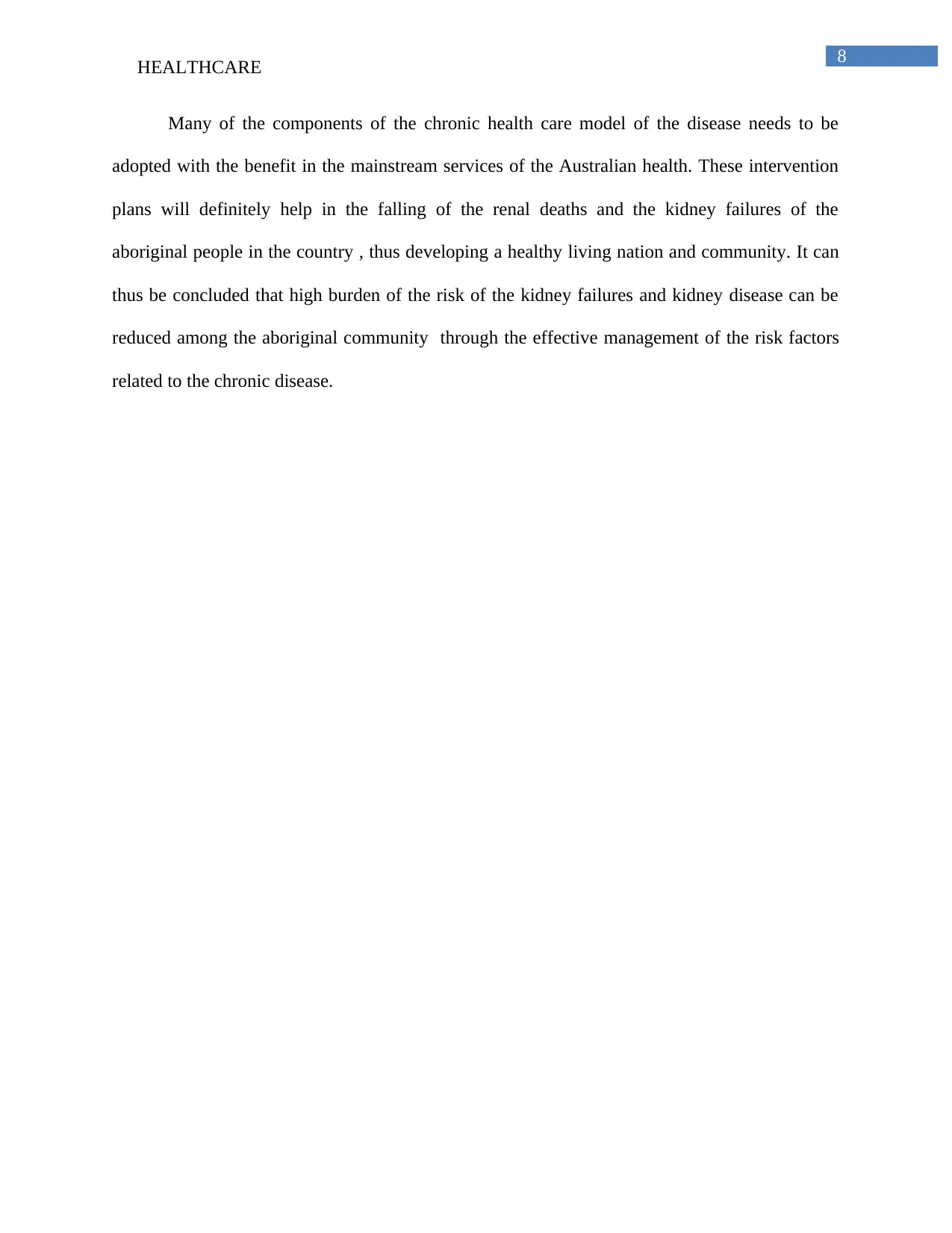
8
HEALTHCARE
Many of the components of the chronic health care model of the disease needs to be
adopted with the benefit in the mainstream services of the Australian health. These intervention
plans will definitely help in the falling of the renal deaths and the kidney failures of the
aboriginal people in the country , thus developing a healthy living nation and community. It can
thus be concluded that high burden of the risk of the kidney failures and kidney disease can be
reduced among the aboriginal community through the effective management of the risk factors
related to the chronic disease.
HEALTHCARE
Many of the components of the chronic health care model of the disease needs to be
adopted with the benefit in the mainstream services of the Australian health. These intervention
plans will definitely help in the falling of the renal deaths and the kidney failures of the
aboriginal people in the country , thus developing a healthy living nation and community. It can
thus be concluded that high burden of the risk of the kidney failures and kidney disease can be
reduced among the aboriginal community through the effective management of the risk factors
related to the chronic disease.
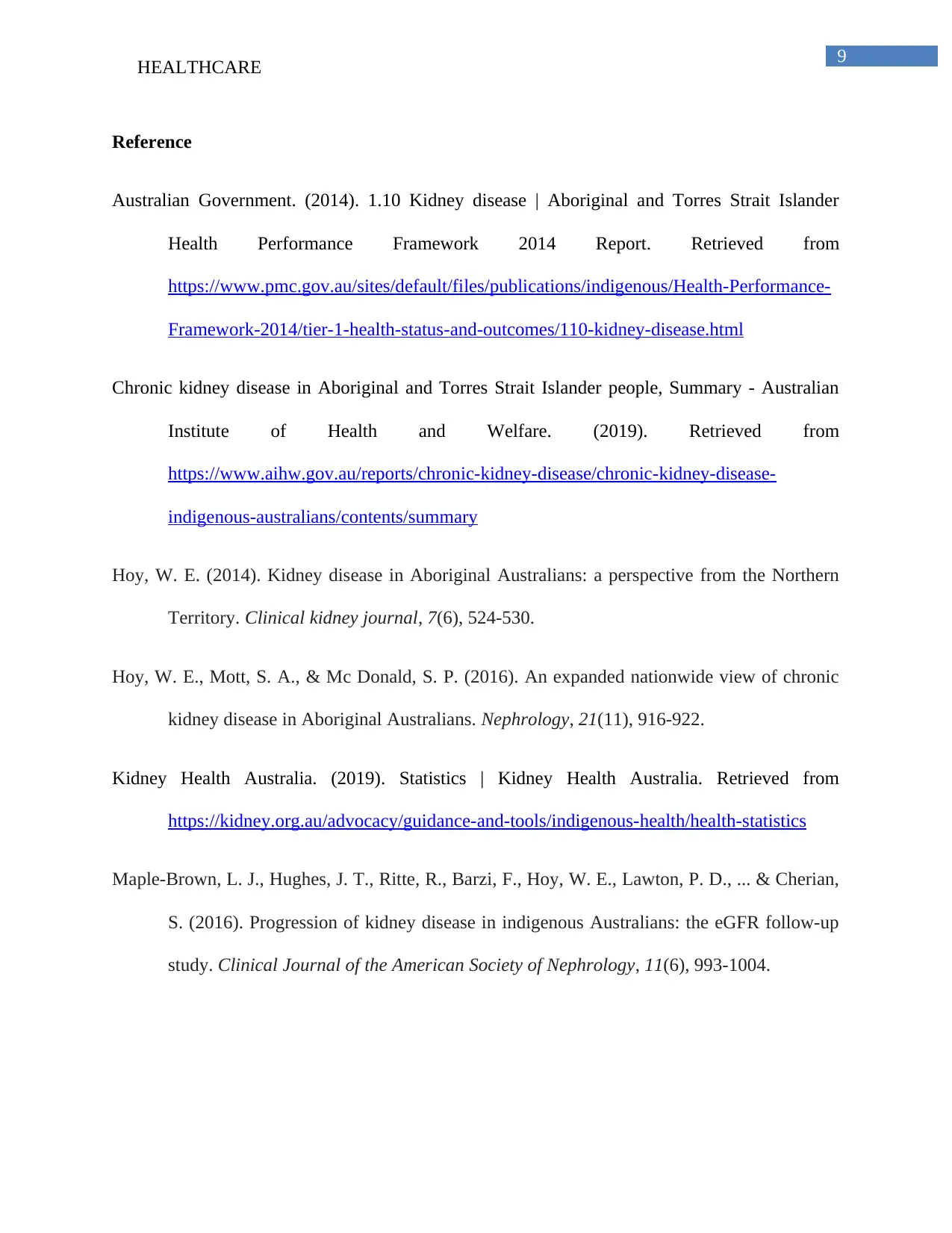
9
HEALTHCARE
Reference
Australian Government. (2014). 1.10 Kidney disease | Aboriginal and Torres Strait Islander
Health Performance Framework 2014 Report. Retrieved from
https://www.pmc.gov.au/sites/default/files/publications/indigenous/Health-Performance-
Framework-2014/tier-1-health-status-and-outcomes/110-kidney-disease.html
Chronic kidney disease in Aboriginal and Torres Strait Islander people, Summary - Australian
Institute of Health and Welfare. (2019). Retrieved from
https://www.aihw.gov.au/reports/chronic-kidney-disease/chronic-kidney-disease-
indigenous-australians/contents/summary
Hoy, W. E. (2014). Kidney disease in Aboriginal Australians: a perspective from the Northern
Territory. Clinical kidney journal, 7(6), 524-530.
Hoy, W. E., Mott, S. A., & Mc Donald, S. P. (2016). An expanded nationwide view of chronic
kidney disease in Aboriginal Australians. Nephrology, 21(11), 916-922.
Kidney Health Australia. (2019). Statistics | Kidney Health Australia. Retrieved from
https://kidney.org.au/advocacy/guidance-and-tools/indigenous-health/health-statistics
Maple-Brown, L. J., Hughes, J. T., Ritte, R., Barzi, F., Hoy, W. E., Lawton, P. D., ... & Cherian,
S. (2016). Progression of kidney disease in indigenous Australians: the eGFR follow-up
study. Clinical Journal of the American Society of Nephrology, 11(6), 993-1004.
HEALTHCARE
Reference
Australian Government. (2014). 1.10 Kidney disease | Aboriginal and Torres Strait Islander
Health Performance Framework 2014 Report. Retrieved from
https://www.pmc.gov.au/sites/default/files/publications/indigenous/Health-Performance-
Framework-2014/tier-1-health-status-and-outcomes/110-kidney-disease.html
Chronic kidney disease in Aboriginal and Torres Strait Islander people, Summary - Australian
Institute of Health and Welfare. (2019). Retrieved from
https://www.aihw.gov.au/reports/chronic-kidney-disease/chronic-kidney-disease-
indigenous-australians/contents/summary
Hoy, W. E. (2014). Kidney disease in Aboriginal Australians: a perspective from the Northern
Territory. Clinical kidney journal, 7(6), 524-530.
Hoy, W. E., Mott, S. A., & Mc Donald, S. P. (2016). An expanded nationwide view of chronic
kidney disease in Aboriginal Australians. Nephrology, 21(11), 916-922.
Kidney Health Australia. (2019). Statistics | Kidney Health Australia. Retrieved from
https://kidney.org.au/advocacy/guidance-and-tools/indigenous-health/health-statistics
Maple-Brown, L. J., Hughes, J. T., Ritte, R., Barzi, F., Hoy, W. E., Lawton, P. D., ... & Cherian,
S. (2016). Progression of kidney disease in indigenous Australians: the eGFR follow-up
study. Clinical Journal of the American Society of Nephrology, 11(6), 993-1004.
1 out of 10
Related Documents
Your All-in-One AI-Powered Toolkit for Academic Success.
+13062052269
info@desklib.com
Available 24*7 on WhatsApp / Email
![[object Object]](/_next/static/media/star-bottom.7253800d.svg)
Unlock your academic potential
© 2024 | Zucol Services PVT LTD | All rights reserved.





